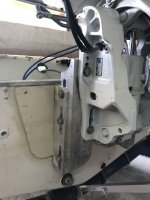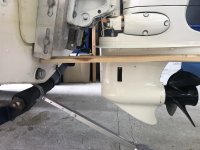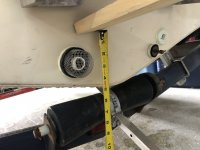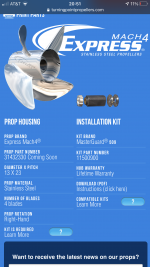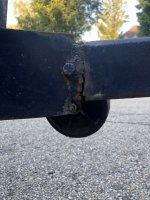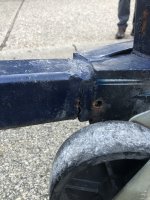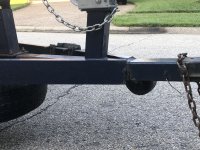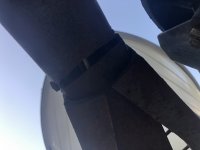MonkeyBird747
Petty Officer 2nd Class
- Joined
- Aug 5, 2020
- Messages
- 112
1974 Starcraft 18’ center console
2004 Johnson 90hp 4-steoke
Vance engineering 4” setback manual jackplate
13x21 4-blade turning point prop
My previous motor was a 25” shaft and my transom is for a long shaft. I used the jackplate to get the motor to a more reasonable height. I recently repowered to the Johnson 4-stroke, with a 20” shaft. I thought about pulling the jackplate off, but decided I’d give it a try at its lowest position first. The lowest position is not as low as it would mount on the transom without the Jack plate.
The motor seemed like it was still sitting too low and digging in at cruise. I thought it was either because of the setback, or because the Johnson weighs 130 pounds more than the 75hp Merc 2-stroke it replaced. Or both. It is a heavy beast. Maybe too heavy. The boat was rated for 125hp in 1974, and the heaviest motor in that size from back then is maybe 300-320 pounds. The Johnson 4-stroke weighs in at 430 pounds. The waterline is just below the drains in the splash well, but it seems to be doing well and doesn’t swamp at all when coming off from full throttle. Max speed is basically exactly what it was with the 75hp 2-stroke, about 35mph on the gps. FWIW, I wasn’t trying to get more speed with the 90hp. The fuel economy difference is very noticeable.
I raised the jackplate up about 3” and it seems better. I still have maybe 5”-6” difference between the pad and prop shaft. If I’m doing the measurement correctly. That’s a big if. It pulls to the right out of the hole and at cruise. I can adjust the torque trim tab a little more to the right on the next run.
What I’m running in to is that I can’t trim the motor up to the sweet spot without it starting to porpoise. I can almost get there, and I start to see a speed boost and the right pull goes away. But at about that same point I get the porpoise.
Not sure where to go from here. Attaching a video clip at cruise. You’ll also see my transducer probably needs to be relocated. Lots of spray. You can also get an idea of about how high the motor is above the transom. I’ll need to measure it to be exact. My understanding is that it needs to be raised by roughly the amount of setback. It seems pretty high to me, but water pump still looking strong, and no blow outs.
I’m thinking of just ditching the jackplate to reduce the moment arm of the heavier motor, so the stern doesn’t sit so low in the water.
Thanks!
MB

2004 Johnson 90hp 4-steoke
Vance engineering 4” setback manual jackplate
13x21 4-blade turning point prop
My previous motor was a 25” shaft and my transom is for a long shaft. I used the jackplate to get the motor to a more reasonable height. I recently repowered to the Johnson 4-stroke, with a 20” shaft. I thought about pulling the jackplate off, but decided I’d give it a try at its lowest position first. The lowest position is not as low as it would mount on the transom without the Jack plate.
The motor seemed like it was still sitting too low and digging in at cruise. I thought it was either because of the setback, or because the Johnson weighs 130 pounds more than the 75hp Merc 2-stroke it replaced. Or both. It is a heavy beast. Maybe too heavy. The boat was rated for 125hp in 1974, and the heaviest motor in that size from back then is maybe 300-320 pounds. The Johnson 4-stroke weighs in at 430 pounds. The waterline is just below the drains in the splash well, but it seems to be doing well and doesn’t swamp at all when coming off from full throttle. Max speed is basically exactly what it was with the 75hp 2-stroke, about 35mph on the gps. FWIW, I wasn’t trying to get more speed with the 90hp. The fuel economy difference is very noticeable.
I raised the jackplate up about 3” and it seems better. I still have maybe 5”-6” difference between the pad and prop shaft. If I’m doing the measurement correctly. That’s a big if. It pulls to the right out of the hole and at cruise. I can adjust the torque trim tab a little more to the right on the next run.
What I’m running in to is that I can’t trim the motor up to the sweet spot without it starting to porpoise. I can almost get there, and I start to see a speed boost and the right pull goes away. But at about that same point I get the porpoise.
Not sure where to go from here. Attaching a video clip at cruise. You’ll also see my transducer probably needs to be relocated. Lots of spray. You can also get an idea of about how high the motor is above the transom. I’ll need to measure it to be exact. My understanding is that it needs to be raised by roughly the amount of setback. It seems pretty high to me, but water pump still looking strong, and no blow outs.
I’m thinking of just ditching the jackplate to reduce the moment arm of the heavier motor, so the stern doesn’t sit so low in the water.
Thanks!
MB


Attachments
Last edited:




















